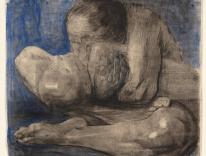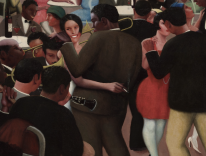Last October the Metropolitan Museum of Art opened its new and expanded Islamic galleries to widespread critical acclaim—“as intelligent as it is resplendent,” Holland Cotter rhapsodized about the renovation in a New York Times review titled “A Cosmopolitan Trove of Exotic Beauty.” Fast on the heels of this triumph, the museum now presents an even greater one in the twenty-six galleries for painting, sculpture, and decorative arts of its now fully-renovated American Wing. Begun seven years ago, the project has unfolded in three phases, with the re-installation of Neo-Classical art completed in 2007, the redesign of the Charles Engelhard Court in 2009, and now the wonderful web of new galleries.
The Met has a long history of supporting homegrown art. The first American painting entered its collection in 1873, and the acquisition of American art was strongly supported by such trustee-painters as Frederic Edwin Church and John Frederick Kensett. But there wasn’t an American Wing until 1924 or a department of American painting until the 1930s; and only in 1980 did the museum open its galleries of American painting and sculpture. Designed by Kevin Roche John Dinkeloo and Associates, those galleries, although a welcome addition to the museum, had certain limitations. The space was claustrophobic and musty; spread over two floors, it was crowded and hard to navigate. In 2001, under the leadership of Morrison Heckscher and his colleagues, the Museum decided on a complete transformation of the American Wing. Kevin Roche agreed to reconceive the space, and donors made bold and generous gifts. The result is a place full of light and wonder—a thirty-thousand-square-foot exhibition space you can wander through without losing your way.
Everything now resides on a single floor—the second—a lovely simplification achieved by literally raising the roof at the far western wall of the museum. The design can be seen as minimalism’s tribute to the Beaux Arts style of the buildings for which much of this art was originally acquired. The walls are painted in a specially designed off-white or oyster, the flooring is white oak; each painting is spot-lit, while the overall wall-wash lighting is computer-adjusted to change with the daylight that pours into the many skylighted galleries. This lets drama arise from the art itself, and from how you choose to approach it—either along broad chronological lines, following several main axes that cut through the various galleries, or with attention to special themes. (Each gallery has a thematic label along with the didactic labels for individual works.)
Taking the elegant glass elevator up to the galleries lets you start, suitably enough, with colonial portraiture. In Matthew Pratt’s The American School (1765) we see Benjamin West instructing visiting artists in London (among them Pratt himself, in profile before a canvas). Nearby, John Singleton Copley’s portrait of patriotic jurist Richard Dana (circa 1770) impresses with its fervent rigor. Overhead looms William Rush’s marvelous golden eagle, sculpted first for the pulpit of St. John’s Evangelical Lutheran Church and later moved to Independence Hall. The eagle points you onward, toward the Grand Gallery and the star attraction of the Wing, Emmanuel Leutze’s Washington Crossing the Delaware (1851). Once an unwanted stepchild of the museum, it is now such a popular favorite that it has been given top billing and a restored frame. Flanking the Leutze are two triumphs of mid-nineteenth-century American heroic landscape, Church’s Heart of the Andes (1859) and Albert Bierstadt’s The Rocky Mountains, Lander’s Peak (1863).
Though “Hudson River School” was once a term of derogation, today nearly everyone seems to love this group of painters, which included Church and Bierstadt and Kensett along with Thomas Cole, Asher Durand, Fitz Henry Lane, Martin Johnson Heade, and others. Their paintings of “the cathedral of nature” are often drenched in nostalgia for the country’s vanishing Edenic vistas, like Cole’s great View on the Catskill—Early Autumn (1837), depicting a landscape that was defaced by a new railroad before Cole could finish the painting. Many of these paintings preserve a deeply American sense of transcendence—like Kensett’s Sunset at Sea, from 1872, which resembles nothing so much as an early (and to my taste more resonant) Rothko. Indeed the two galleries dedicated to these majestic paintings make the once fashionable American Impressionism (also given two galleries) seem in comparison embarrassingly fussy and imitative.
Two galleries of “Life in America” in the mid–nineteenth century overlap with one on the “Civil War Era.” The former include well-known genre scenes by George Caleb Bingham, William Sidney Mount, and Eastman Johnson, but also two scruffy, revelatory paintings of very ordinary people: Moving Day (in Little Old New York) and The Five Points, by an unknown artist. The centerpiece of the Civil War gallery is Winslow Homer’s Prisoners from the Front (1866), first shown to great acclaim in 1867 at the Exposition Universelle in Paris. Nearby is the anecdotal but nevertheless essential Bit of War History (1865–66) by Thomas Waterman Wood, a triptych illustrating a black soldier’s poignant story in three progressive stages. The museum is particularly proud of its most recent acquisition, a bronze version of Augustus Saint-Gaudens’s Abraham Lincoln: The Man (1884–87). (The full-scale original stands in Chicago’s Lincoln Park.) The Met’s Saint-Gaudens collection also includes the unforgettable tondo relief of Robert Louis Stevenson and the model of Victory for New York’s Grand Army Plaza, plus larger pieces in the Engelhard Court. Visitors to the new galleries may be excused for leaving with the impression that Saint-Gaudens is the star of the show.
Away from the more celebrated works, the new wing contains many rooms of homelier treasures; a visitor can wander among the collections of colonial silver and chests and chairs. Along the main axis you’ll find a long gallery devoted to the revolutionary era and a smaller one with “Faces of the Young Republic.” George Washington is celebrated by Charles Willson Peale, who sees him as a younger officer, and more famously by Gilbert Stuart, reverencing the mature president. Among the folk artists gathered in Gallery 757 are some long-term loans from the American Folk Art Museum, including a gorgeous array of duck decoys and Ammi Phillips’s charming Girl in Red Dress with Cat and Dog (1834–36). And the four galleries behind the Grand Gallery present life in America, studio scenes, images of the West (including James Earle Fraser’s End of the Trail, a particularly poignant 1918 bronze of a mounted Native American), and in Gallery 766—“The Cosmopolitan Spirit”—a Whistler and two amazingly modern Albert Pinkham Ryders.
For this particular visitor, nothing quite matches Gallery 767, dedicated exclusively to Winslow Homer and Thomas Eakins—the greatest American painters of their time. Containing Eakins’s early The Champion Single Sculls (Max Schmitt in a Single Scull) and several late Homer seascapes, the room throbs with American individuality. When you come then to the gallery titled “Portraiture in the Grand Manner,” two rooms over, with its moody Whistler and splashy Sargents, Eakins’s The Thinker: Portrait of Louis N. Kenton from 1900 seems awkwardly out of place. But clearly its inclusion is meant to signal the transition to the final gallery of Ashcan artists such as Robert Henri and William Glackens. Eakins’s careful study of a very ordinary man hints at changes to come in the century ahead.
Who are we, really, we Americans in this land of unparalleled abundance and increasing cultural diversity? Such questions are political as well as artistic, and indeed the new wing has attracted comment from politicians: “What a way to show our American history and values,” exclaimed Hillary Rodham Clinton at the gala dinner for the new galleries; and Michael Bloomberg, in a less serious tone, later pronounced the renovation “the best face-lift on the East Side.”
The new wing is not above criticism. Some charge that the art has been installed too thematically—and that it presents a rather homogenized view of American life. Time will tell, of course, but what seems indisputable is that the new spaces are wonderfully inviting and remarkably flexible. When the hoped-for renovation of the Modern and Contemporary Art Wing comes along, perhaps a still more complicated series of stories will be told. But meanwhile, in the great panoply the Met currently offers in its grand new wing, America appears at once stirringly patriotic and very day-to-day; full of hope but acquainted with grief; rich and poor and black and white; instinctively religious yet seriously secular: a New World indeed, sown with provocative questions that an afternoon spent touring its riches will only multiply.
Please email comments to [email protected] and join the conversation on our Facebook page.
Previous Story
Re-Reading
Next Story
Graceless Education


